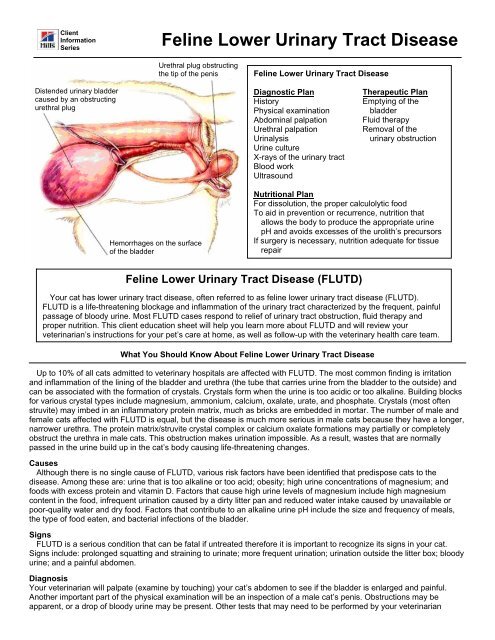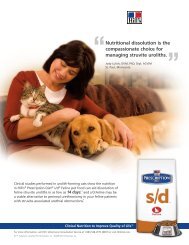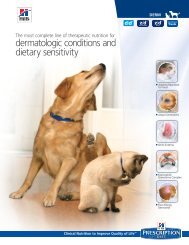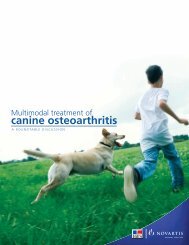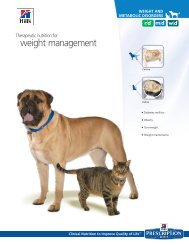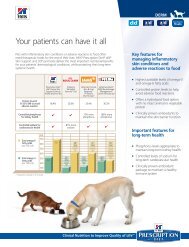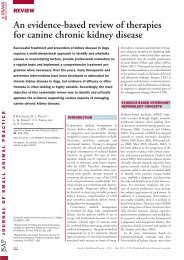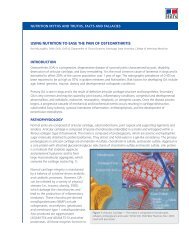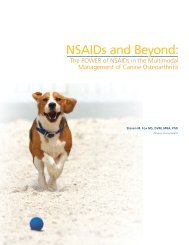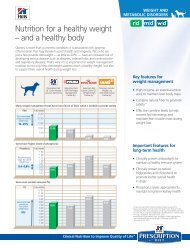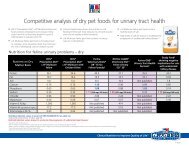Feline Lower Urinary Tract Disease - HillsVet
Feline Lower Urinary Tract Disease - HillsVet
Feline Lower Urinary Tract Disease - HillsVet
You also want an ePaper? Increase the reach of your titles
YUMPU automatically turns print PDFs into web optimized ePapers that Google loves.
Client<br />
Information<br />
Series<br />
Distended urinary bladder<br />
caused by an obstructing<br />
urethral plug<br />
<strong>Feline</strong> <strong>Lower</strong> <strong>Urinary</strong> <strong>Tract</strong> <strong>Disease</strong><br />
Urethral plug obstructing<br />
the tip of the penis<br />
Hemorrhages on the surface<br />
of the bladder<br />
<strong>Feline</strong> <strong>Lower</strong> <strong>Urinary</strong> <strong>Tract</strong> <strong>Disease</strong><br />
Diagnostic Plan<br />
History<br />
Physical examination<br />
Abdominal palpation<br />
Urethral palpation<br />
Urinalysis<br />
Urine culture<br />
X-rays of the urinary tract<br />
Blood work<br />
Ultrasound<br />
<strong>Feline</strong> <strong>Lower</strong> <strong>Urinary</strong> <strong>Tract</strong> <strong>Disease</strong> (FLUTD)<br />
Your cat has lower urinary tract disease, often referred to as feline lower urinary tract disease (FLUTD).<br />
FLUTD is a life-threatening blockage and inflammation of the urinary tract characterized by the frequent, painful<br />
passage of bloody urine. Most FLUTD cases respond to relief of urinary tract obstruction, fluid therapy and<br />
proper nutrition. This client education sheet will help you learn more about FLUTD and will review your<br />
veterinarian’s instructions for your pet’s care at home, as well as follow-up with the veterinary health care team.<br />
What You Should Know About <strong>Feline</strong> <strong>Lower</strong> <strong>Urinary</strong> <strong>Tract</strong> <strong>Disease</strong><br />
Therapeutic Plan<br />
Emptying of the<br />
bladder<br />
Fluid therapy<br />
Removal of the<br />
urinary obstruction<br />
Nutritional Plan<br />
For dissolution, the proper calculolytic food<br />
To aid in prevention or recurrence, nutrition that<br />
allows the body to produce the appropriate urine<br />
pH and avoids excesses of the urolith’s precursors<br />
If surgery is necessary, nutrition adequate for tissue<br />
repair<br />
Up to 10% of all cats admitted to veterinary hospitals are affected with FLUTD. The most common finding is irritation<br />
and inflammation of the lining of the bladder and urethra (the tube that carries urine from the bladder to the outside) and<br />
can be associated with the formation of crystals. Crystals form when the urine is too acidic or too alkaline. Building blocks<br />
for various crystal types include magnesium, ammonium, calcium, oxalate, urate, and phosphate. Crystals (most often<br />
struvite) may imbed in an inflammatory protein matrix, much as bricks are embedded in mortar. The number of male and<br />
female cats affected with FLUTD is equal, but the disease is much more serious in male cats because they have a longer,<br />
narrower urethra. The protein matrix/struvite crystal complex or calcium oxalate formations may partially or completely<br />
obstruct the urethra in male cats. This obstruction makes urination impossible. As a result, wastes that are normally<br />
passed in the urine build up in the cat’s body causing life-threatening changes.<br />
Causes<br />
Although there is no single cause of FLUTD, various risk factors have been identified that predispose cats to the<br />
disease. Among these are: urine that is too alkaline or too acid; obesity; high urine concentrations of magnesium; and<br />
foods with excess protein and vitamin D. Factors that cause high urine levels of magnesium include high magnesium<br />
content in the food, infrequent urination caused by a dirty litter pan and reduced water intake caused by unavailable or<br />
poor-quality water and dry food. Factors that contribute to an alkaline urine pH include the size and frequency of meals,<br />
the type of food eaten, and bacterial infections of the bladder.<br />
Signs<br />
FLUTD is a serious condition that can be fatal if untreated therefore it is important to recognize its signs in your cat.<br />
Signs include: prolonged squatting and straining to urinate; more frequent urination; urination outside the litter box; bloody<br />
urine; and a painful abdomen.<br />
Diagnosis<br />
Your veterinarian will palpate (examine by touching) your cat’s abdomen to see if the bladder is enlarged and painful.<br />
Another important part of the physical examination will be an inspection of a male cat’s penis. Obstructions may be<br />
apparent, or a drop of bloody urine may be present. Other tests that may need to be performed by your veterinarian
include: examination of urine with the aid of a microscope to reveal the presence of crystals; urine culture; X-rays;<br />
ultrasound; and blood tests.<br />
Treatment and Home Care<br />
If your cat’s urinary tract is blocked your veterinarian will remove the blockage and empty your cat’s bladder. Sometimes<br />
your cat may need to be sedated to unblock. Many veterinarians will insert a catheter into the bladder and hospitalize the<br />
cat until it is urinating normally. Fluid therapy is often necessary to correct dehydration, restore normal electrolyte balance<br />
and hasten the removal of urinary wastes from the blood stream.<br />
Once you’ve taken your cat home, you’ll need to follow your veterinarian’s instructions carefully and monitor your cat to<br />
reduce the likelihood of recurrence. You should provide free access to fresh, clean water and give all prescribed<br />
medications. Provide a clean litter pan for each cat in the household. Veterinary behaviorist recommend providing one<br />
litter box for each cat, plus one additional litter box. Encourage your cat to exercise by planning daily play sessions.<br />
Return to the hospital for all follow-up lab tests.<br />
Nutritional Plan<br />
If you cat has FLUTD, your veterinarian may give you special feeding instructions. Many FLUTD patients benefit from<br />
foods that reduce minerals in the urine (the building blocks of struvite such as magnesium and phosphorus) and allow a<br />
more acid urine. Such foods include Hill’s® Prescription Diet® s/d® <strong>Feline</strong> Dissolution. In cats fed this special food<br />
exclusively, signs associated with FLUTD will normally cease within the first five to seven days. Prescription Diet® s/d® is<br />
usually fed for 30 to 60 days to dissolve struvite crystals.<br />
If your cat has calcium oxalate crystals, your veterinarian may recommend a food with reduced oxalate and protein to<br />
reduce the acidity of the urine. Such foods include Prescription Diet® c/d® Multicare <strong>Feline</strong> Bladder Health.<br />
Because foods that produce an alkaline urine and have a high magnesium content are risk factors for FLUTD, many<br />
cats will have a recurrence of FLUTD if they resume eating their regular food. Your veterinarian may recommend a special<br />
food to help control these nutritional risks. Such foods include Prescription Diet® c/d®, which has a reduced magnesium<br />
content and allows for the maintenance of a normal acid urine. Prescription Diet® c/d® can be fed to help prevent struvite<br />
crystals from forming after your cat has completed the 30 to 60 day course of Prescription Diet® s/d® therapy for<br />
dissolving struvite crystals already present in the urinary tract.<br />
Transitioning Food<br />
Unless recommended otherwise by your veterinarian, gradually introduce any new food over a seven-day period. Mix<br />
the new food with your pet’s former food, gradually increasing its proportion until only the new food is fed.<br />
If your pet is one of the few that doesn’t readily accept a new food, try warming the canned food to body temperature,<br />
hand feeding for the first few days, or mixing the dry food with warm water (wait ten minutes before serving). Feed only<br />
the recommended food. Be patient but firm with your pet. This is important because the success or failure of treatment<br />
depends to a large degree on strict adherence to the new food.<br />
Presented as an educational service by<br />
Home Care Instructions<br />
Client’s Name: _________________________________________________________<br />
Patient’s Name: _________________________________________________________<br />
Medication(s): _________________________________________________________<br />
Nutritional Recommendation: ___________________________________________________<br />
Follow-Up Appointment: _______________________________________________________ (Hospital Stamp Area Above)<br />
REGULAR VISITS WILL HELP OUR VETERINARY HEALTH CARE TEAM PROVIDE FOR YOUR PET’S BEST INTEREST.<br />
©2011 Hill’s Pet Nutrition, Inc.<br />
®/ Trademarks owned by Hill’s Pet Nutrition, Inc.


